Clan Turnbull
|
|
CREST: A bull’s head MOTTO: I Saved The King TRANSLATION: N/A VARIATIONS: N/A |
| The story of Clan Turnbull’s origins is as fascinating as it is legendary. According to the 16th-century historian Boece, the clan’s roots can be traced back to a Borders man named Rule. It is said that Rule saved the life of King Robert the Bruce by turning away an angry bull that was set to gore the king. In gratitude, Robert the Bruce bestowed upon him the name “Turnbull” and granted him lands known as “bedrule,” a reference to their fortunate new owner.
While this legend adds a touch of romanticism to the clan’s history, it’s important to note that such tales often become embellished over time. A more likely derivation of the name “Turnbull” is believed to be from the Old English word “trumbald,” signifying strength or boldness. This theory gains support from the pronunciation of the name as “Trumell” in Teviotdale, which aligns with the English derivation. Clan Turnbull’s distinctive coat of arms features three bull’s heads. This design is an example of canting arms, where the elements in the arms play on words or puns related to the family name. In this case, the bull’s heads serve as a visual representation of the clan’s name, “Turnbull.” Such heraldic symbolism is a common feature in Scottish clan history, adding layers of meaning to their identities. The Turnbulls were known as one of the most turbulent of the Borders families, their history punctuated by bold actions and fierce tempers. In one notable incident, prior to the Battle of Halidon Hill in 1333, a Turnbull approached the English host, accompanied by a massive mastiff, and challenged anyone to single combat. Sir Robert Benhale accepted the challenge and dispatched both the mastiff and its master, reportedly severing Turnbull’s left arm and head. Throughout history, members of Clan Turnbull held lands across the Borders region. William Turnbull received a charter from Robert the Bruce in 1315 for land near Philiphaugh, and John Turnbull was granted the lands of Hundleshop by David II. John Turnbull, nicknamed “outwith sword” for his fierce temper, found himself listed as a Scots prisoner of war in England around 1400. The clan’s influence extended beyond the battlefield. William Turnbull, Bishop of Glasgow, played a pivotal role in the establishment of the University of Glasgow in 1451. He procured a charter from the pope to create this educational institution, a testament to his vision and dedication to learning. In more recent times, Clan Turnbull has produced individuals who have made their mark in various fields, from ornithology to mathematics. William Turnbull, the 19th-century American ornithologist, was born in Midlothian, Scotland. Herbert Turnbull, a distinguished mathematician, left a significant legacy in the study of algebra. |
|
Citations:
|
|
Purchase @ Redbubble
Purchase @ Amazon.com
Purchase @ Amazon.co.uk

